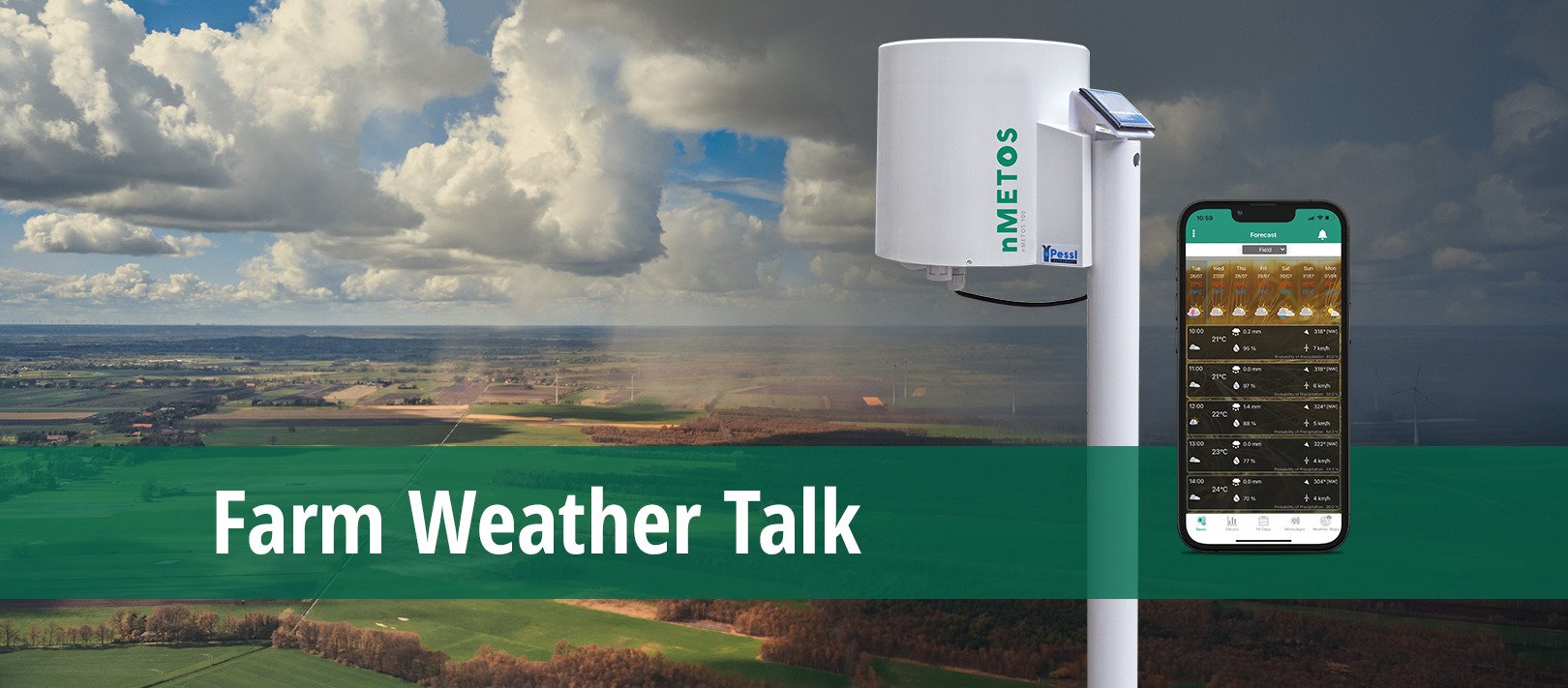We all talk about the weather and in fact it’s a conversation starter for many people and in farming it’s more often than not the talk around coffee. In farming, weather impacts are usually the key risk for financial success or failure.
Farm Weather Talk #001
In northern hemisphere production, it’s responsible for up to 70% of the uncontrollable risk farmers face each year and this risk is increasing with climate variability. Let’s think about that, up to 70% of the income we have is controlled by mother nature, “Weather”!
Well, what can be done regarding the impacts of weather on a farming production system?

We need to do more than talk about it but manage the impacts in a timely manner to reduce risk. This is where a field specific weather station or IoT device comes into play. The site-specific device can deliver a multitude of information from the field, from temperature, relative humidity, leaf wetness, precipitation, wind speed/direction, solar radiation, soil temperature/moisture, ET, delta T, etc. in near real-time.
Ok, it sounds like a lot of information, and what do we do with the info?
- Temperature information can provide us details on frost potential, growing degree days for crop staging, and precipitation provides us with the supply side of the equation for a water balance that drives yields and product efficacy.
- ET0 is the water demand side of the equation, which is calculated via temperature, relative humidity, wind speed, and solar radiation, or the amount of water the plant needs each hour and day.
- Wind speed/direction and delta T are important in all spray applications.
- Temperature, relative humidity, and leaf wetness drive the disease processes.
As you can see, the list of field-specific applications is extensive so the return on investment for any one of these management issues is high.
For example, targeting yields based on known field-specific soil water supply can boost returns or reducing the impact of plant disease pressure can preserve yields, these cost tens of thousands of dollars in any field farming system. In addition to these benefits, information from each sensor can be sent as an alert to inform a user that a defined criteria has been met, e.g., winds from the west at 20 kph.
As we can see, the benefit of a site-specific field weather station or IoT device can help reduce the impacts of “Uncontrollable Risk” that farmers face based on the weather to date, but it’s only half of the weather solution, the other part is the forecast. Yes, we need to discuss weather forecasts, since the future impacts of weather on the field are as important, if not more important, as the conditions up to date.
But how do we have an accurate weather forecast for a field?
Today, like many other industries, the ability to compute large datasets is becoming easier and faster. This allows meteorologists to create specific forecasts that are based on the weather data from the field-specific station. Yes, the data from the field station helps to nudge and tune the forecast. In addition, the forecast becomes smart for the field but learning the local conditions with the help of AI (Artificial Intelligence).
This is further enhanced with an ensemble approach, multiple models weighted for performance, for forecasting. What does all this mean? It means that you now have a field-specific forecast that is updated hourly for the next 7 days which is highly accurate (accuracy I will discuss in another Farm Weather Talk instalment) and is not based on the closest town but built based on your field device.
So, what do we do with these field-specific forecasts?
- First, they give us insight into the conditions for many field operations, a gut check to the decisions that are being made, like are the winds favorable for spraying over the next 24, 48 or 72 hours.
- The forecasts also get added to work planning tools/solutions like sowing windows, plant protection, harvest conditions, tillage ability, field accessibility, and plant nutrition. These solutions are hourly windows into the conditions for each operation.
- The site-specific forecasts can also be added to the disease risk models, which then provide a prediction of the future conditions of the next 24, 48 or 72 hours.
- Of course, yield prediction can also be based on a future forecast, but this uses a seasonally adjusted forecast to make an estimate of the potential water supply for yield prediction over the growing season.
When deciding to buy a weather station or IoT device for your farm/fields, always include the site-specific weather forecast. The station and forecast should be thought of as peanut butter and jelly, they go hand in hand with farm management decisions.
About the Author:
Guy Ash has worked as agro-meteorologist and earth observations science specialist for the past 30 years. Currently, he is the Global Training and Key Accounts Manager in Canada for Pessl Instruments, Austria. Pessl Instrument is an IoT company that manufactures hardware (loggers and sensors) and software solutions that are focused on the agricultural sector. We work in over 85 countries and have over 70,000 devices and 700,000 sensors deployed for a wide range of agriculture applications: disease management, irrigation, soil moisture, insect traps, crop cameras, weather stations, soil fertility, etc. One of his roles is to provide global training for an extensive list of IoT solutions for a wide variety of crops – rice, wheat, soybeans, oranges, corn, canola, forages, grapes, fruits and vegetables, etc.
![]()
